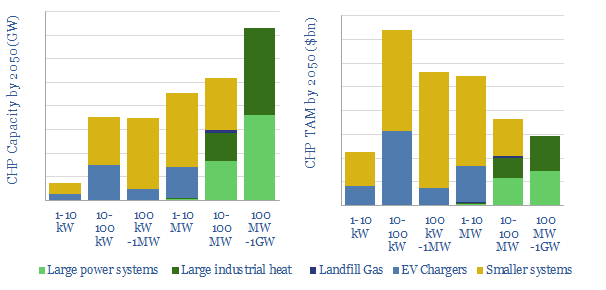Combined heat and power systems are 20-30% lower-carbon than today’s gas turbines, as they capture waste heat. They are also increasingly economical to backstop renewable-heavy grids. Amidst uncertain policies, the US Combined Heat and Power Market Size could vary by a factor of 100x. We find 30 companies well-placed in a possible $9trn global market through 2050.
What are CHPs and why do they matter? Gas turbines have been in use for power generation since the late 1930s. They usually range from 500kW to 300MW capacity. We outline how they work, why CHPs are more efficient, and why they could be well-placed for backstopping renewables on pages 2-3.
Five future markets could exist for CHPs. We have quantified the opportunity in large-scale power (page 4), industrial heat (page 5), landfill gas (page 5), EV fast-charging (page 6) and smaller-scale residential/commercial systems (page 6).
The costs of CHPs can also be favorable, and can readily generate double-digit IRRs at MW-scale, mostly derived from the spread between commercial power prices and commercial gas prices, especially under our thesis for rising electricity prices.
The ultimate market can thus be assessed by adding together each use case. But future policies are uncertain. We find the total addressable market in the US by 2050 could be anywhere ranging from $30bn to $3trn, i.e., an uncertainty level of 100x (pages 7-9).
Amazing progress is nevertheless being made, despite the policy uncertainty, as we have tracked new developments from thirty leading companies, aiming to make gas turbines more efficient for the energy transition (pages 10-11).
